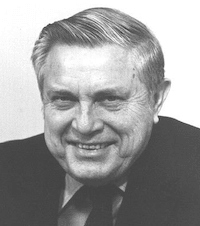Virgil Boekelheide
1919 – 2003
Virgil Boekelheide died in his sleep on September 24, 2003, in Eugene, Oregon. He was 84, and although he had been retired from his position at the University of Oregon for many years, he retained an active interest in both chemistry and the musical arts to the end of his life. Virgil was born in Chelsea, South Dakota, to parents of German descent, and his early education was at a small school in Northville, South Dakota, from which he graduated at the age of fifteen. He completed an A.B. degree Magna cum Laude from Dakota Wesleyan University in 1939 and then attended the University of Minnesota where he received his Ph.D. under C.F. Koelsch in 1943. Virgil began his independent academic career that year as an Instructor at the University of Illinois, and from there he moved in 1946 to the University of Rochester where he remained until 1960. His final move was to the University of Oregon where he spent a highly productive 24 years until his retirement in 1984.
Virgil Boekelheide’s early research focused on alkaloid chemistry, but this merely served as the entry point to the main theme which occupied him through the rest of his career – the synthesis of structurally intriguing molecules with interesting chemical properties. To a large extent, this interest centered on non-benzenoid aromatic systems, and his 1964 PNAS paper describing the synthesis of a 15,16-dihydropyrene is acknowledged as one of the classics of the organic literature. This work led to a fundamental advance in the annulene field by creating a \[14\]-annulene with substituents positioned inside the π cloud, and Boekelheide soon capitalized on this brilliant accomplishment by demonstrating remarkable electronic and chemical properties of his new system. The dihydropyrene synthesis illustrated a second structural feature associated with annulenes, namely that transannular steric interactions could be removed and annulenes stabilized by replacing internal hydrogens with carbon-carbon bonds. This important principle has become a pivotal component of annulene design and has been used to great advantage, for example by Emmanuel Vogel in his syntheses of methano-bridged annulenes.
Boekelheide’s success in this area led seamlessly to a second major research endeavor, the construction of stacked aromatic systems in the form of cyclophanes. The culmination of this effort was the spectacular preparation of “superphane,” a compound in which two benzene rings are clamped together by six ethano bridges. This unique molecule in which the pair of benzene decks are separated by less than the distance between graphite layers was long considered among the “holy grails” of organic synthesis, and the Boekelheide accomplishment must surely rank among the major achievements in the field.
Virgil Boekelheide’s long and distinguished career in science was recognized with numerous awards including election to the National Academy of Sciences in 1962, the first Oregonian to be so honored. He also received a Guggenheim Fellowship (1953), an Alfred P. Sloan Fellowship (1958), a Fulbright Distinguished Fellowship (1953), and Senior Alexander von Humboldt Fellowships in 1974 and 1982. These last two awards enabled Virgil to build extremely fruitful and congenial collaborations with colleagues in Germany who shared his research interests. Foremost among these individuals was Professor Henning Hopf at the Technical University of Braunschweig who remained a lifelong friend of Virgil’s. Virgil’s welcoming disposition encouraged a large number of international scholars to join his research group, and many of these continue to practice the special brand of novel and exciting chemistry that Virgil has left as his legacy. Virgil Boekelheide joined the Board of Editors of Organic Syntheses in 1956 and edited Volume 62. He retired from the Board in 1964.
In his later years and especially after his retirement, Virgil became an active patron of the arts, and he contributed substantial donations to the opera, ballet and symphonic organizations in his hometown of Eugene. For his philanthropic participation in these activities, he was elected President of the Eugene Ballet Society where he served from 1988-1991. Virgil was deservedly proud of his role in stimulating artistic as well as scientific accomplishment, and in 1994, he and his wife Caroline established an endowment fund at the University of Oregon with the unusual mission of supporting “teaching and research in chemistry, music, and dance.”
Virgil Boekelheide is survived by his wife of 58 years, Caroline, his sons, Erich and Karl, his daughter, Anne, his brother Irving, his sister Dorothy Anderson, and his grandchildren, Amanda and David.
James D. White, Corvallis, Oregon


